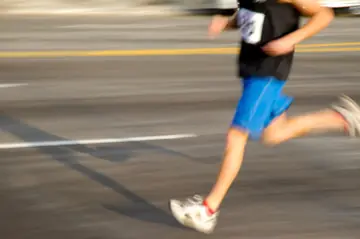Discover Your Weak Link(s)
1 of 15
What should be the primary focus? Understanding your body's strengths and weaknesses will help you choose what your body needs most. Take a systematic approach to regaining structural integrity. Most of us have a weak link—generally something we feel we're not good at, or it could be something that we just don't spend the time on.
Take a Quick Self-Assessment
2 of 15
Ask yourself these questions about your performance last year: •What are you not spending time on? •Have you been injured? •Have you watched a video of yourself running? A little guidance and some time spent on these three areas can and will make a difference in your performance and give you a strong, aligned body.
The Foundation-Building Trifecta
3 of 15
The three areas to focus on for performance-boosting benefits: 1. Strength training 2. Joint mobility 3. Running technique
Strength Training
4 of 15
Strength training can be a foreign activity to many endurance athletes. The main issue that I see with endurance athletes is weak glutes. The glutes are the primary mover that should fire every running stride. Squats and deadlifts are the best exercises to increase glute strength.?
Increase Gluteal Strength
5 of 15
Bulgarian split squat
To take gluteal strength training a step further, try single-leg pistol squats, Bulgarian split squats and single-leg deadlifts. These exercises will correct your running muscular imbalances. Switch to unilateral (single leg) exercises to focus on each glute and hamstring, allowing you to work each leg equally.
Tips for Progression
6 of 15
pistol squat
Be patient when moving to single-leg exercises. Start with no weight to learn the technique, and focus your eyes on an object on the horizon to assist with balance. After the proper technique is learned, be progressive—each time you do one of these exercises, it should be harder than the week before. Add weights or increase reps to add load. ??
Joint Mobility
7 of 15
Higher mileage, poor mechanics and poor posture contribute to joint dysfunction and muscular imbalances. The soft tissue that surrounds your joints can get beat up. If you ignore your soft tissue, eventually an injury will occur.
Ease Inflammation
8 of 15
The foam roller and lacrosse ball can help reduce inflammation. The most common problem areas: Achilles, soleus, calf, IT band/TFL, psoas and chest.Self-myofascial release can be painful, but consistent work on these areas will restore proper length of the muscle and take pressure off of the sounding joints.?
2 Best Stretches for Runners
9 of 15
pigeon stretch
Two stretching exercises incredibly useful to runners are pigeon and an active kneeling hip flexor stretch. Pigeon targets your tight hips, and helps the pelvis restore correct position.
Loosen Up Your Hips
10 of 15
kneeling hip flexor stretch
The kneeling hip flexor stretch releases the overactive hip flexors. A few minutes with these two stretches can go a long way.?
Running Technique
11 of 15
Your running form can always use work. It's no different from working on a golf swing, or shooting a free throw. Running economy matters—the less energy used, the better the performance. Strength training and joint mobility will help increase your running economy.?
Improve Your Cadence
12 of 15
Sean Ryan, owner of By Positive Energy Physical Therapy in Redondo Beach, California, advises his patients to land softly, attempting to minimize the length of time the foot is in contact with the ground. "I teach runners how to count their steps, advising a goal of 85 to 90 steps/min. The combo of soft landing with a high cadence will serve most runners very well," says Ryan.?
Take Time to Learn a New Trick
13 of 15
Allow time for your head and nervous system to adapt to the proper motion and feel of the 85-to-90-steps-per-minute cadence. Although there are many components to good running form, learning the proper foot strike is the best place to start.
Assign Goals to Your Winter Training
14 of 15
Think of the wintertime as an opportunity to change up your daily running routine, and a time to put your body in a better position to perform and stay injury-free.?
Get ACTIVE on the Go


Couch to 5K®
The best way to get new runners off the couch and across the finish line of their first 5K.
Available for iOS | Android






Discuss This Article